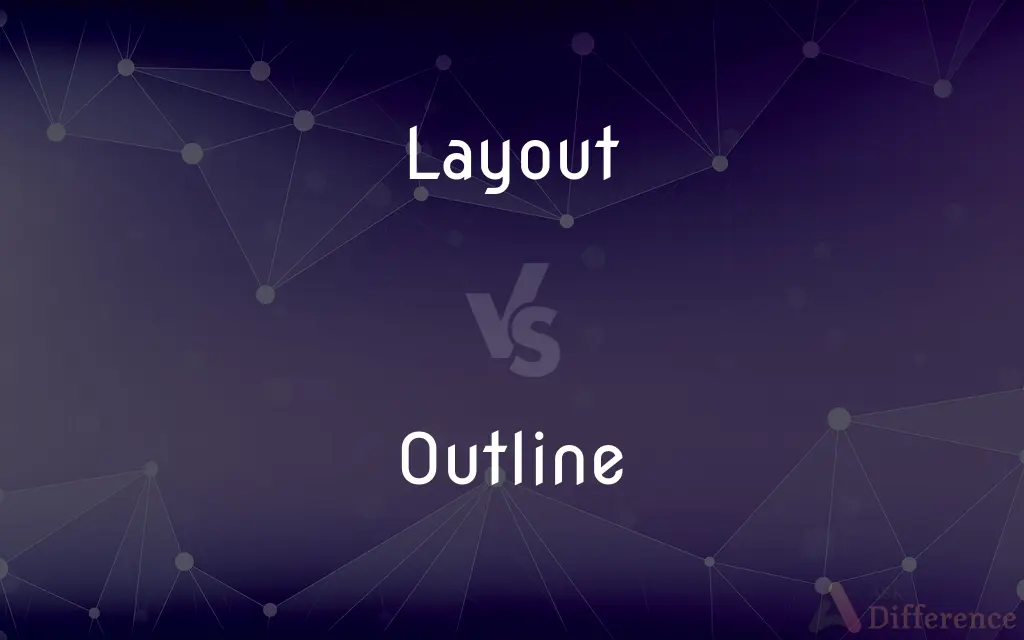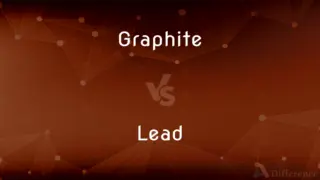Layout vs. Outline — What's the Difference?
Edited by Tayyaba Rehman — By Maham Liaqat — Updated on March 2, 2024
Layout focuses on the arrangement of elements within a space, while Outline emphasizes the structure and summary of content.

Difference Between Layout and Outline
Table of Contents
ADVERTISEMENT
Key Differences
Layout and Outline are crucial concepts in various fields, differing primarily in their focus and application. Layout pertains to the physical arrangement or the design of elements within a given space. It is concerned with the visual aspect, how components like text, images, and shapes are organized on a page or in a digital interface. On the other hand, Outline refers to a skeletal structure or a framework that summarizes the main points or content of a document, presentation, or project, focusing on the hierarchical organization of ideas rather than visual design.
In graphic design, layout is key to ensuring that the visual flow guides the viewer's eye in a manner that is both aesthetically pleasing and functionally effective. This involves considerations of balance, contrast, and alignment. Conversely, in writing or planning, an outline serves as a blueprint for the content, helping to organize thoughts and arguments in a logical sequence, ensuring that all essential points are covered and clearly defined.
The layout is influenced by principles of design such as proximity, alignment, repetition, and contrast, aiming to create a cohesive and visually engaging experience. An outline, however, relies on logical structuring, often using bullet points or numbered lists to denote the priority and relationship between different sections of content.
Creating a layout often involves software tools specialized for design, such as Adobe Photoshop or InDesign, where visual elements are manipulated to achieve the desired look. Outlining, in contrast, may utilize word processing software or dedicated outlining tools that focus on text manipulation and hierarchical organization.
The effectiveness of a layout is judged by its visual impact and its ability to communicate the intended message or function aesthetically. The success of an outline is measured by its clarity, coherence, and ability to serve as a reliable guide for further content development or project management.
ADVERTISEMENT
Comparison Chart
Focus
Visual arrangement of elements
Structure and summary of content
Application
Graphic design, web design
Writing, planning
Key Considerations
Balance, contrast, alignment
Logical sequence, hierarchy
Tools Used
Design software (e.g., Photoshop, InDesign)
Word processors, outlining tools
Outcome Measure
Visual impact, communication effectiveness
Clarity, coherence, comprehensiveness
Compare with Definitions
Layout
The arrangement of visual elements in a space, focusing on aesthetics and functionality.
The magazine's layout was carefully designed to guide the reader's eye through the articles.
Outline
A tool for organizing thoughts and ideas in a hierarchical manner.
Before writing her essay, she created an outline to organize her arguments.
Layout
A crucial aspect of graphic and web design, emphasizing visual appeal.
The layout of the poster emphasized the event details with vibrant colors and bold fonts.
Outline
A structured summary of a document or presentation, highlighting main points.
The author's outline for the novel included all major plot points and character arcs.
Layout
Involves the organization of text, images, and other elements in design and architecture.
The architect's layout of the apartment maximized natural light and space.
Outline
Essential in planning and structuring content across various fields.
The project manager used an outline to detail the phases of the construction project.
Layout
A plan or blueprint for arranging elements in various mediums.
The web designer created a layout that was both attractive and user-friendly.
Outline
A preliminary framework that guides content development or project management.
The outline for the conference covered every session, including speakers and topics.
Layout
Aesthetic and functional arrangement meant to enhance comprehension and experience.
The layout of the infographic made complex data easily understandable.
Outline
A method for ensuring logical flow and coverage of all necessary points in content creation.
His outline ensured that the research paper addressed all required elements systematically.
Layout
The way in which the parts of something are arranged or laid out
The road layout
Outline
A line indicating the outer contours or boundaries of an object or figure
Could see the outlines of an animal in the dark.
Layout
The act or an instance of laying out.
Outline
A style of drawing in which objects are delineated in contours without shading.
Layout
An arrangement or plan, especially the schematic arrangement of parts or areas
The layout of a factory.
The layout of a printed circuit.
Outline
A summary of a text or subject, usually presented in headings and subheadings.
Layout
The art or process of arranging printed or graphic matter on a page.
Outline
Fig.: A sketch of any scheme; a preliminary or general indication of a plan, system, discourse, course of thought, etc.; as, the outline of a speech.
But that larger grief . . .Is given in outline and no more.
Layout
The overall design of a page, spread, or book, including elements such as page and type size, typeface, and the arrangement of titles and page numbers.
Outline
Fig.: To sketch out or indicate as by an outline; to create a general framework of (a plan, system, discourse, course of thought), for which the details need to be added; as, to outline an argument or a campaign.
Layout
A structured arrangement of items within certain limits.
Outline
A sketchy summary of the main points of an argument or theory
Layout
The act of laying out something.
Outline
Draw up an outline or sketch for something;
Draft a speech
Layout
A plan or design of something that is laid out
Common Curiosities
Which should be created first, layout or outline?
Typically, the outline is created first to establish the content's structure, followed by the layout for visual arrangement.
Can layout and outline be used together in a project?
Yes, they often complement each other, with the outline guiding the content's structure and the layout focusing on the visual presentation.
How do layout and outline contribute to project management?
Layout aids in visualizing project elements, while outlining helps in structuring tasks and timelines, both essential for planning.
Can a good outline compensate for a poor layout in presentations?
A good outline ensures content quality, but a poor layout can hinder audience engagement and message delivery.
Is outlining necessary for short documents?
While not always necessary, outlining can improve clarity and structure, even in shorter documents.
What role does an outline play in academic writing?
It serves as a roadmap for structuring arguments, ensuring thorough exploration of topics, and logical progression.
What is the main difference between layout and outline?
Layout focuses on the visual arrangement of elements, while an outline emphasizes the structure and summary of content.
Are layouts more important for digital or print media?
Layouts are crucial for both, but the specific considerations may differ due to the medium's nature (e.g., screen size, paper format).
How does an outline benefit the writing process?
It helps organize thoughts, ensures logical flow, and covers all necessary points, making the writing process more efficient.
Do digital tools for layout and outline serve the same purpose?
No, digital tools for layout focus on design aspects, while tools for outlining focus on organizing and structuring content.
Why might a layout need to be revised after initial design?
Revisions may be necessary to improve functionality, aesthetics, or to better align with the content or user feedback.
Can the layout affect the user's experience on a website?
Absolutely, a well-designed layout enhances usability, aesthetics, and navigation, significantly impacting the user experience.
How does one choose between different layout designs?
Choices should be based on the project's goals, the intended audience, and the content's nature, aiming for clarity and impact.
How detailed should an outline be?
The level of detail depends on the project's complexity and the creator's preference, but it should cover all major points and sections.
Can layout techniques be applied to non-visual projects?
While primarily visual, layout principles of organization and hierarchy can influence non-visual project structuring.
Share Your Discovery

Previous Comparison
Spin vs. Roll
Next Comparison
Graphite vs. LeadAuthor Spotlight
Written by
Maham LiaqatEdited by
Tayyaba RehmanTayyaba Rehman is a distinguished writer, currently serving as a primary contributor to askdifference.com. As a researcher in semantics and etymology, Tayyaba's passion for the complexity of languages and their distinctions has found a perfect home on the platform. Tayyaba delves into the intricacies of language, distinguishing between commonly confused words and phrases, thereby providing clarity for readers worldwide.














































